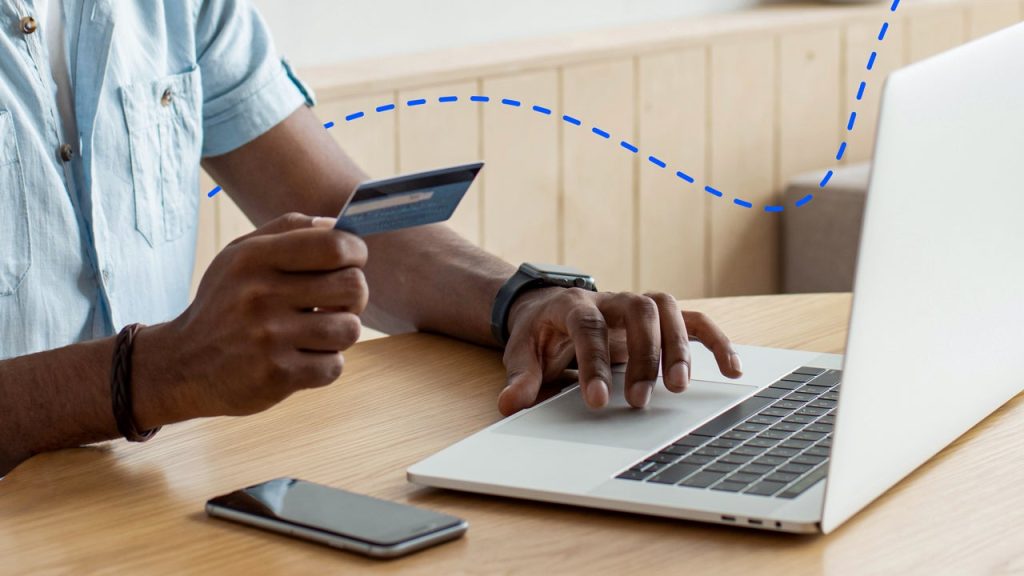Key takeaways
- If you are willing to jump through a few extra hoops, you can use one credit card to pay off another.
- The most common strategy for paying one credit card with another requires a new balance transfer credit card.
- Be aware of balance transfer fees, which vary from card to card but usually range from 3 percent to 5 percent of the total transferred balance.
Technically, yes, you can pay off one credit card with another card, but you’ll have to jump through a few hoops to make it happen. The most straightforward way to do this is via a balance transfer, which allows you to move debt from one card to another card, ideally one with better terms or even an introductory 0 percent APR period.
Whether getting a balance transfer credit card is the right solution for managing high-interest credit card debt is entirely up to you. But with the right 0 percent intro APR offer and a certain level of discipline, it could be a worthwhile option.
How to pay a credit card with another credit card
There are a couple of ways you could consider paying one credit card with another. The first, a balance transfer, can be a great option to help you manage your debt. The second, however, is a cash advance. While it’s possible to use a cash advance to pay off another credit card, it’s highly inadvisable.
Let’s talk about the good option first.
Pay a credit card with a balance transfer
Credit card issuers usually state they only accept checks, electronic bank transfers and money orders when you pay your bill each month, but there’s a workaround that technically allows you to pay one credit card with another. You can transfer the balance from one card to another one, effectively paying off the first card with another credit card.
To start this process, you’ll want to look over the best balance transfer cards available today. Compare them based on the length of their introductory offers, and keep in mind that some cards offer 0 percent APR on balance transfers for up to 21 months. Also, look at credit card balance transfer fees, which tend to be 3 percent or 5 percent of the balance amount transferred.
Check your credit score
Before you apply for a balance transfer card, you’ll also want to check your credit score. This is because, by and large, the best balance transfer credit cards require good or excellent credit. If your credit needs some work, you may want to work on paying down some existing debt and improving your credit score before you apply.
Once you have a new balance transfer card in hand, you can use the following steps to pay off one credit card with another:
- Step 1: Compare your new credit limit to your existing debt. When you’re approved for a new balance transfer credit card, you’re assigned a credit limit that is hopefully higher than the debt amount you need to transfer. If not, you’ll only be able to transfer some of your old debt to your new card — not all of it.
- Step 2: Initiate the balance transfer online or via convenience checks. Depending on your card, you may be able to initiate a balance transfer online, over the phone or via balance transfer convenience checks you receive in the mail. Information you need to provide includes your old account number, debt amount you need to transfer and mailing address for your old credit card issuer.
- Step 3: Wait for your balance to transfer. Most balance transfers take five to seven days to go through, but it’s possible you could wait much longer than that.
- Step 4: Keep making payments on your old card. Make sure to keep up with monthly payments on your old card while you wait for some or all of the existing debt to be transferred. The minimum amount you can pay is sufficient here.
- Step 5: Confirm your old credit card balance is $0. If your entire balance is transferred to your new card, you’ll want to confirm your old credit card balance is $0 before you stop making payments. If you were only able to transfer some of your debt, you’ll need to make payments on your old card and your new balance transfer card at the same time.
What to consider before transferring a balance
To get the most out of using a balance transfer card, look for cards that have no annual fees and perhaps even offer rewards or other perks that give the card long-term value beyond your balance transfer needs. Here are a few other considerations to keep in mind:
- Is there a balance transfer fee? Balance transfer fees typically range from 3 percent to 5 percent of the total balance you transfer to your new card. For example, for every $10,000 you transfer, you’ll need to pay an additional $300 or $500 in fees. If you are looking to transfer a much smaller balance, there’s typically a minimum charge in place, anywhere from $5 to $10. It may sound like a lot to add an extra amount to your balance, but
- What will your new credit limit be? When it comes to credit limits, there is no guarantee that you’ll be approved for an amount that’s sufficient for large balance transfers. If you’re looking to transfer a large balance and your new card’s credit limit falls short, you’ll be stuck paying off two balances.
- When does the 0 percent intro APR offer end? To get the most out of your balance transfer card, ensure you can pay off the entire balance before the 0 percent intro APR period ends. If you still have a balance when the intro ends, that balance will begin accruing interest at the regular interest rate. It’s important to know how long your offer lasts so you can create a plan to pay off your debt before the higher APR starts.
- How will your credit score be impacted? Paying off debt with a balance transfer card will also affect your credit score in a few ways. Applying for a new card will trigger an inquiry into your credit report, which will temporarily lower your score a bit. Opening a new card will drop your accounts’ average age, which could also drop your score a bit. However, that new card may also help to lower your credit utilization ratio, which may help your score to improve over time. Plus, giving you some breathing room to pay off debt will help your score in the long run.
As long as you carefully consider the pros and cons, the right balance transfer credit card can help you manage your debt interest-free and pay it down (or pay it off entirely) during a 0 percent intro APR period. These 0 percent intro APR offers often last anywhere from 12 to 21 months, which could provide the just what you need to pay off one credit card with another.
Pay a credit card with a cash advance
Before we dive into how to pay a credit card with a cash advance, we want to share an important warning: While you can use your credit card to get a cash advance, then use those funds to pay off your old credit card balance, this method of paying one credit card with another is rarely, if ever, a good idea due to the expensive nature of credit card cash advances.
If you do decide to use a cash advance to pay off another credit card, the process will ultimately look involve paying your credit card with a check, bank draft or money order after you’ve completed your cash advance.
You can complete a cash advance via an ATM, bank teller or sometimes with a courtesy check. You’ll request a cash withdraw against your line of credit and then use that cash to pay off your credit card.
A credit card cash advance typically requires an upfront fee — usually 5 percent of the advance amount — along with a higher interest rate. Additionally, cash advances begin accruing interest immediately rather than after the interest-free grace period you typically enjoy on purchases. The fees and the immediately accruing interest make this an expensive method of paying off a credit card.
What to consider before getting a cash advance
Before you use your credit card for a cash advance, ask yourself if you’ve exhausted all other options available to you. After all, credit card cash advances are among the most costly ways to use credit, and the additional costs they incur make it significantly more difficult to get out of debt.
In almost every case, you’ll be much better off paying off credit card debt slowly with the card you have or transferring a balance to a new 0 percent APR credit card if you can qualify.
Benefits of paying a credit card with another credit card
There are several benefits that come from using a balance transfer credit card to pay off another credit card bill, although some of them will vary based on your situation. Consider the following advantages and if they could apply to you:
- Save money on interest. If you’re using a balance transfer to go from a credit card with a high interest rate to a new 0 percent APR credit card, you’ll save quite a bit on interest right off the bat. The savings can continue for the length of the card’s balance transfer offer, which could be anywhere from 12 to 21 months depending on the card.
- Pay down debt faster. Without any interest accruing on the account, every dollar you pay toward the debt goes directly toward the principal you owe. This can help you pay down debt significantly more quickly.
- Simplify debt repayment. If you paid off several credit cards with one new balance transfer card, you may find a much simpler debt repayment process. Having just one credit card bill to pay each month makes debt repayment easier to manage.
Drawbacks of paying a credit card with another credit card
There are also some downsides to transferring balances between credit cards. These can include:
- You’ll pay balance transfer fees. Balance transfer fees can be worth paying due to interest savings, but they still add to the cost of paying off one credit card with another.
- You’re moving debt around. Note that moving a balance from one card to another doesn’t actually pay off debt. Unless you put real effort into paying down the balance, the move is nothing more than a shell game.
- You could end up with even more debt in the end. If you pay off your credit card with a new one but keep using the old card for new purchases, you could wind up with a worse debt problem than when you started.
Tips to pay off credit card debt
While a balance transfer card may be a tool to help you pay off debt, it’s not a magic solution. Paying off debt and keeping it under control isn’t always easy — just ask the 48 percent of Americans who carry credit card debt from month to month, according to Bankrate’s Credit Card Debt Survey. Here are some steps to keep in mind:
Know how much you owe
When debt starts piling up, it’s often easier to ignore what you owe than to crunch the numbers. However, the first step to getting out of debt is knowing the full amount in black and white. So, sit down with all of your bills — car loan, medical bills, credit cards, etc. — and make a list of what you currently owe for each bill. Make sure you note any interest rates that will be added on as well (these are an important factor in paying off your debt).
Make a debt payoff plan
There are a variety of balance transfer cards out there that will offer you a 0 percent intro APR period to help you pay off the debt you’ve transferred. The best balance transfer cards offer 0 percent intro APR periods for 15 to 21 months, after which you’ll be responsible for any remaining balance plus added interest.
Before transferring your debt, take the time to figure out how much you will need to pay each month to pay off the debt before your 0 percent intro APR offer ends. If you need some help crunching the numbers, try out our credit card payoff calculator.
Create a payment schedule
Once you’ve calculated how much you’ll need to pay each month to pay off your debt, make a payment schedule — and stick to it. Late fees will only add to your existing debt, so it’s important that you pay your bills on time. If you have the option, set up automatic payments to ensure consistent payments and help avoid late or missed payments.
Handle high-interest debt first
If you are dealing with debt from multiple places, handle your high-interest debt first. A balance transfer card’s 0 percent intro APR period will give you a chance to pay off that debt without having to worry about paying high interest for a while. For other debts, continue to pay your minimum payment each month until the high-interest debt is taken care of.
Use available tools
Paying off debt starts with knowing where you stand. Consumers can get a free copy of their credit reports weekly from AnnualCreditReport.com. Additionally, many banks provide free access to credit scores, which is an easy way to quickly check and monitor your current score.
Another tool that’s helpful for debt repayment is setting up account alerts for when payments are due. This is especially helpful if setting up auto payments is not an option.
Keep your options open
Balance transfer cards are helpful tools, but they aren’t for everyone. If your credit is not in a good place to add another card to your rotation, you may want to look at other options for paying off credit card debt. For instance, you could look into a debt management service to help you negotiate payment options with your creditors. Or you could pay off the credit card debt with a personal loan, as those loans may have lower interest rates than credit cards.
The bottom line
Paying off credit card debt feels amazing, and paying off one card with another via a balance transfer offer can often be the key to getting there. However, paying off debt may not last very long if your spending habits don’t change. As you work to pay off your debt, also come up with a working budget for your current and future spending to keep your debt in check.
Read the full article here









